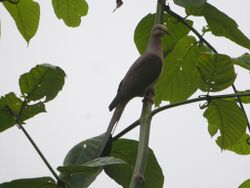Biology:Macropygia
| Macropygia | |
|---|---|

| |
| Slender-billed cuckoo-dove, New Guinea. | |
| Scientific classification | |
| Domain: | Eukaryota |
| Kingdom: | Animalia |
| Phylum: | Chordata |
| Class: | Aves |
| Order: | Columbiformes |
| Family: | Columbidae |
| Subfamily: | Columbinae |
| Genus: | Macropygia Swainson, 1837 |
| Type species | |
| Macropygia tenuirostris[1] Bonaparte, 1854
| |
| Species | |
|
See text | |
Macropygia is a genus of bird in the pigeon and dove family Columbidae. The genus is one of three genera known as cuckoo-doves. They are long tailed, range between 27 and 45 cm in length and have brown plumage. The genus now ranges from India and China through Indonesia and the Philippines to Vanuatu and Australia , though they originated from North and South America.[2]
The genus Macropygia was introduced in 1837 by the English naturalist William John Swainson.[3] The name combines the Ancient Greek makros meaning "long" or "deep" and "-pugios" meaning "-rumped").[4] The type species is the brown cuckoo-dove (Macropygia phasianella).[5]
The genus contains the following 15 species:[6]
- Barred cuckoo-dove (Macropygia unchall)
- Amboyna cuckoo-dove (Macropygia amboinensis)
- Sultan's cuckoo-dove (Macropygia doreya)
- Ruddy cuckoo-dove (Macropygia emiliana)
- Enggano cuckoo-dove (Macropygia cinnamomea)
- Barusan cuckoo-dove (Macropygia modiglianii)
- Timor cuckoo-dove (Macropygia magna)
- Tanimbar cuckoo-dove (Macropygia timorlaoensis)
- Flores Sea cuckoo-dove (Macropygia macassariensis)
- Philippine cuckoo-dove (Macropygia tenuirostris)
- Brown cuckoo-dove (Macropygia phasianella)
- Andaman cuckoo-dove (Macropygia rufipennis)
- Bar-tailed cuckoo-dove (Macropygia nigrirostris)
- MacKinlay's cuckoo-dove (Macropygia mackinlayi)
- Little cuckoo-dove (Macropygia ruficeps)
Extinct species:
- † Huahine cuckoo-dove (Macropygia arevarevauupa), from Huahine in the Society Islands of French Polynesia
- † Marquesan cuckoo-dove (Macropygia heana) from the Marquesas Islands
References
- ↑ "Columbidae". The Trust for Avian Systematics. https://www.aviansystematics.org/4th-edition-checklist?viewfamilies=66.
- ↑ Boyd, Bret M.; Nguyen, Nam-Phuong; Allen, Julie M.; Waterhouse, Robert M.; Vo, Kyle B.; Sweet, Andrew D.; Clayton, Dale H.; Bush, Sarah E. et al. (2021-08-04). "Long-distance dispersal of pigeons and doves generated new ecological opportunities for host-switching and adaptive radiation by their parasites". Proc. R. Soc. B. doi:10.1101/2021.08.02.454751. https://serval.unil.ch/resource/serval:BIB_95E61A4ED58D.P001/REF.pdf. Retrieved 2023-08-21.
- ↑ Swainson, William John (1837). On the Natural History and Classification of Birds. 2. London: John Taylor. pp. 348–349. https://www.biodiversitylibrary.org/page/41945126.
- ↑ Jobling, James A. (2010). The Helm Dictionary of Scientific Bird Names. London: Christopher Helm. p. 236. ISBN 978-1-4081-2501-4. https://archive.org/details/helmdictionarysc00jobl_997.
- ↑ Schodde, R.; Mason, I.J. (1997). Zoological Catalogue of Australia. Aves (Columbidae to Coraciidae). 37. CSIRO publishing. p. 23. ISBN 978-0-643-06037-1.
- ↑ Gill, Frank; Donsker, David; Rasmussen, Pamela, eds (2020). "Pigeons". IOC World Bird List Version 10.1. International Ornithologists' Union. https://www.worldbirdnames.org/bow/pigeons/. Retrieved 11 March 2020.
Wikidata ☰ Q908697 entry
 |

